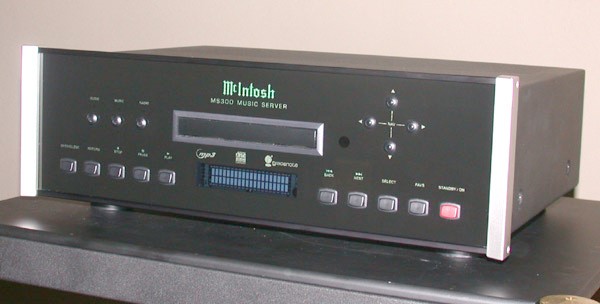That Enchanting Look

What McIntosh review would be complete without a bit of fawning over the
comeliness of the MS300's design. In the looks department, the MS300 has it
all over the competition. The sheen cast by the glass veneer and the
wonderfully eerie green illumination, a staple of the McIntosh line,
highlights the retro charm of the MS300's well populated knobs and buttons
visage. With the lights down, this baby shines like no other. In fact, it is
one of the few pieces in m y system that visitors immediately noticed upon
its addition. "Hey that wasn't here the last time I was over," was the
typical response from those who had been over pre-McIntosh.
y system that visitors immediately noticed upon
its addition. "Hey that wasn't here the last time I was over," was the
typical response from those who had been over pre-McIntosh.
Having seen Mac products at various trade shows, I took it on principle that
the MS300 would have an impeccable fit and finish. Needless to say, I was
surprised to find the faceplate was loose to the point of being able to be
pushed inward toward the chassis. These build oddities appeared on the back
panel also where the power cord dangled precariously from its receptacle. On
a couple of occasions, I happened to bump into my equipment rack and noticed
the MS300 lost power from the loose connection. Aside from those flaws, the
quality of materials and solidity of buttons presses and toggles gave that
reassuring feel that the MS300 was designed to last.
Sonic Performance
I realize the main selling point of a music server is in the convenience it
provides, but for me, sonic performance is critical, and here the McIntosh
clearly delivered. On Redbook audio digitally captured in lossless mode, I
could discern no tangible difference between the MS300 and my reference
current digital reference Pioneer 59avi. I ran the musical gamut of my
collection from Bjork and Beck, and the gist of the experience was that both
sources sounded wonderful through the digital inputs of the Anthem D1. I can
safely say the MS300 was more than competent
sonically.
I was able to evaluate the performance of the MS300's A/D stage on the
two-channel recording I made of "The Golden Age" off Beck's Sea Change in SACD.
Since an analog recording is currently the only option for those who wish to
put SACD/DVD-A material on the MS300, I felt it important to gauge its
performance in this area. Played back through the digital out of the MS300,
the track sounded remarkably similar to my usual high-resolution connection
which is the Pioneer 59avi's analog out to the D1's 5.1 analog in (in both
analog bypass and A/D mode on the D1). If I had to get ultra critical, I
would say there was a loss of air and resolution compared to playing it
through the Pioneer, but overall the presentation was quite good, and without
direct comparison, hard to fault. My collection of SACD and DVD-A material is
small enough that I do not mind getting up to swap discs so for me the loss
in sound quality, however slight, justified using the Pioneer for all
high-resolution material. For the lazy or less picky among us, I am sure the
analog captured version would suffice.
Before I get into operational performance, I should comment on the iRadio
feature. The MS300 boasts a sizeable collection of internet radio stations
all played back with varying levels of compression. I took a look through
the available stations and actually managed to find some interesting
selections that play music you wouldn't find on a traditional radio station
in a million years. The MS300 even allows you to add stations by manually
entering a valid URL. I have listened to quite a bit of Internet radio
played back via the no-fi integrated speaker system of my G5, so I was
curious to see how the streams would fair on the MS300.
Unfortunately played
through my reference rig I received a healthy dose of compression reality.
While some of the higher bitrate stations sounded serviceable, I'm talking
100kbps and up here, some of the low bitrate stations sounded thin and
harsh. It actually served as a useful reminder how easy it is to accept
inferior source material when played back on inferior equipment. Once you
hear a heavily compressed source on a higher end system, the amount of
information that is lost in the translation becomes glaring. That said, I
could happily listen to the less compressed stations on a regular basis, as
the deleterious compression artifacts were far less evident.
The iRadio caveat aside, it was quite a relief to be able to take the MS300's
audio performance for granted. For its main function of serving as a digital
source for PCM based music, I found it indistinguishable from my current
digital source, and that is exactly what the end user should expect/need to
justify its inclusion in his or her system.
Click Here to Go to Part V.